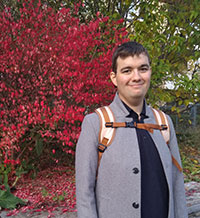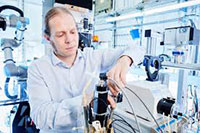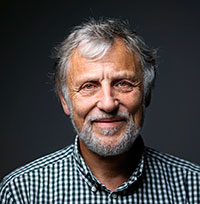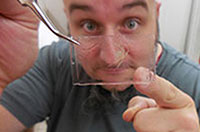 Viktor Baranov. Estación Biológica de Doñana-CSIC, Avd. Americo Vespucio 26, 41092 Seville, Spain. viktor.baranov@ebd.csic.es. Corresponding author.
Viktor Baranov. Estación Biológica de Doñana-CSIC, Avd. Americo Vespucio 26, 41092 Seville, Spain. viktor.baranov@ebd.csic.es. Corresponding author.
Viktor Baranov studied biology (BSc) and zoology & animal ecology (MSc, honors) at the V.N. Karazin Kharkiv National University (Ukraine). After completion of the Master degree in 2011, he worked for two years as a adjunct at the department of zoology of his alma mater, teaching medical zoology and parasitology. Between 2011 and 2013 he visited number of the international labs, including entomological laboratory of the Bergen University Museum (Norway), Gdansk laboratory of the amber Palaeobiology(Poland) and Zoological Institute in St. Petersburg (Russia). In 2014 Viktor Baranov has won Marie Curie early career fellowship, which allowed him to pursue phd in the ecology and biogeochemical impact of the aquatic insects on the carbon and oxygen cycles in lakes. After receiving his phd in Environmental and Earth science (2017) from Humboldt University of Berlin, he proceeded for a 1.5 year postdoc in the department of River Ecology and Conservation of Senckenberg Museum (Gelnhausen), working on long term trends in aquatic insect communities. Since October 2018 till December 2022 he worked in the Joachim Haug’s research group (LMU Munich), dealing with evolutionary biology and ecology of the Holometabolan insects larvae. Currently he is starting his own research group at the Estación Biológica de Doñana-CSIC / Doñana Biological Station-CSIC (Seville, Spain), funded by the Ramon y Cajal tenure-track-fellowship, from Agencia Estatal de Investigación-AEI.
![]()
 Jörg Hammel. Helmholtz-Zentrum Hereon, Institute of Materials Physics, Max-Planck-Straße 1, 21502 Geesthacht, Germany. joerg.hammel@hereon.de
Jörg Hammel. Helmholtz-Zentrum Hereon, Institute of Materials Physics, Max-Planck-Straße 1, 21502 Geesthacht, Germany. joerg.hammel@hereon.de
Jörg U. Hammel is working as Scientist in Helmholtz-Zentrum Geesthacht Zentrum für Material- und Küstenforschung. He worked as Postdoctoral Scientist in Friedrich-Schiller-Universität Jena and University of Amsterdam. He have received his Diploma in Technical biology from the University of Stuttgart and his PhD in Zoology from Friedrich-Schiller-Universität Jena.
![]()
 Carsten Gröhn. University of Hamburg, Mittelweg 177, 20148 Hamburg, Germany. ambertop@t-online.de
Carsten Gröhn. University of Hamburg, Mittelweg 177, 20148 Hamburg, Germany. ambertop@t-online.de
Carsten Gröhn was born in Mölln, Schleswig-Holstein, in 1949. He studied biology at the University of Kiel and taught biology at the Gymnasium Glinde for more than 40 years. For 30 years, he has been an enthusiastic collector of amber – his primary interest lies in amber inclusions, especially those in Baltic amber. His aim is to provide amber enthusiasts with comprehensive information. Both his website ambertop.de and the standard reference work ALLES ÜBER BERNSTEIN are widely read in German. Furthermore, he is author and co-author of various other books and publications on amber. As chairman for the Society for the Promotion of the Geological-Paleontological Museum of the University of Hamburg (“Arbeitskreis Bernstein”), he presides over more than 200 amber enthusiasts from around the globe.
![]()
 Joachim T. Haug. Ludwig-Maximilians-Universität München, Großhaderner Str. 2, 82152 Planegg-Martinsried, Germany. jhaug@biologie.uni-muenchen.de
Joachim T. Haug. Ludwig-Maximilians-Universität München, Großhaderner Str. 2, 82152 Planegg-Martinsried, Germany. jhaug@biologie.uni-muenchen.de
Joachim T. Haug studied animal ecology (major), sociobiology and palaeontology (minors) at the Julius-Maximilians-Universität Würzburg. After the receipt of the Diplom in 2005, he moved to the work group Biosystematic Documentation at the University of Ulm for his PhD thesis. There he worked on the early crustaceans from the Cambrian 'Orsten', which are preserved three-dimensionally and with minute details. To make the entire morphology clearly visible, Joachim produced computer-based 3D models for each developmental stage of a species, resulting in a 4D model of the species. With 4D models reconstructed for the different species, differences in the developmental pattern between the species became visible. These changes in the developmental timing, so-called heterochronic events must have occurred several times during early crustacean evolution. Due to these findings, Joachim got interested in studying such evolutionary changes of development also in fossils from other deposits and focussed on Palaeo-Evo-Devo (see also http://www.palaeo-evo-devo.info). After his defense in 2009 and two further years as postdoctoral researcher in Ulm, he received two Feodor Lynen research fellowships from the Alexander von Humboldt-Foundation, with which he was doing research at Yale University and at the Ernst-Moritz-Arndt-Universität Greifswald. Besides 3D modelling, Joachim is also interested in different methods of imaging (documentation and presentation). In September 2013, he relocated to the Ludwig-Maximilians-Universität in Munich. In April 2018 Joachim became a Lichtenberg professor at the Ludwig-Maximilians-Universität München (LMU Munich) funded by the Volkswagen Foundation.

